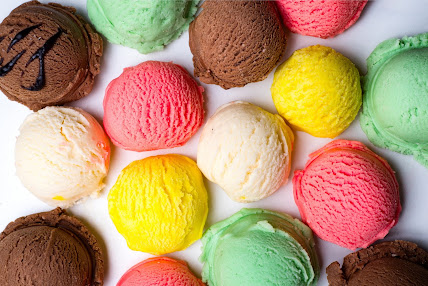Thursday, October 31, 2024
Happy Halloween
Sunday, October 27, 2024
15 Chillingly Fun Facts About Ice Cream
Thursday, October 24, 2024
Ingredients and Standards of Ice Cream
Many countries have regulations controlling what can be described as ice cream.
In the U.S., the FDA rules state that to be described as "ice cream", a product must have the following composition:
- greater than 10% milk fat
- 6 to 10% milk and non-fat milk solids: this component, also known as the milk solids-not-fat or serum solids, contains the proteins (caseins and whey proteins) and carbohydrates (lactose) found in milk
It generally also has:
- 12 to 16% sweeteners: usually a combination of sucrose and glucose-based corn syrup sweeteners
- 0.2 to 0.5% stabilizers and emulsifiers
- 55 to 64% water, which comes from the milk or other ingredients.
These compositions are percentage by weight. Since ice cream can contain as much as half air by volume, these numbers may be reduced by as much as half if cited by volume. In terms of dietary considerations, the percentages by weight are more relevant. Even the low-fat products have high caloric content: Ben and Jerry's No-Fat Vanilla Fudge contains 150 calories (630 kJ) per half-cup due to its high sugar content.
According to the Canadian Food and Drugs Act and Regulations, ice cream in Canada is divided into Ice cream mix and Ice cream. Each have a different set of regulations.
- Ice cream must be at least 10 percent milk fat, and must contain at least 180 grams of solids per litre. When cocoa, chocolate syrup, fruit, nuts, or confections are added, the percentage of milk fat can be 8 percent.
- The ice cream mix is defined as the pasteurized mix of cream, milk and other milk products that are not yet frozen. It may contain eggs, artificial or non-artificial flavours, cocoa or chocolate syrup, a food colour, an agent that adjusts the pH level in the mix, salt, a stabilizing agent that doesn't exceed 0.5% of the ice cream mix, a sequestering agent which preserves the food colour, edible casein that doesn't exceed 1% of the mix, propylene glycol mono fatty acids in an amount that will not exceed 0.35% of the ice cream mix, and sorbitan tristearate in an amount that will not exceed 0.035% of the mix. The ice cream mix may not include less than 36% solid components.
Read more, here.
Monday, October 21, 2024
How Delicious Candy is Made | Modern Marvels (16, E11) | Full Episode
Friday, October 18, 2024
Specialty Jobs in Ice Cream
Today, jobs specialize in the selling of ice cream. The title of a person who works in this speciality is often called an 'ice cream man', however women also specialize in the selling of ice cream. People in this line of work often sell ice cream on beaches. On beaches, ice cream is either sold by a person who carries a box full of ice cream and is called over by people who want to purchase ice cream, or by a person who drives up to the top of the beach and rings a bell. In the second method, people go up to the top of the beach and purchase ice cream straight from the ice cream seller, who is often in an ice cream van. In Turkey and Australia, ice cream is sometimes sold to beach-goers from small powerboats equipped with chest freezers.
Some ice cream distributors sell ice cream products from travelling refrigerated vans or carts (commonly referred to in the US as "ice cream trucks"), sometimes equipped with speakers playing children's music or folk melodies (such as "Turkey in the Straw"). The driver of an ice cream van drives throughout neighbourhoods and stops every so often, usually every block. The seller on the ice cream van sells the ice cream through a large window; this window is also where the customer asks for ice cream and pays. Ice cream vans in the United Kingdom make a music box noise rather than actual music.
Read more, here.
Tuesday, October 15, 2024
Retail Sales of Ice Cream
Ice cream can be mass-produced and thus is widely available in developed parts of the world. Ice cream can be purchased in large cartons (vats and squrounds) from supermarkets and grocery stores, in smaller quantities from ice cream shops, convenience stores, and milk bars, and in individual servings from small carts or vans at public events. In 2015, the US produced nearly 900 million gallons of ice cream.
Read more, here.
Saturday, October 12, 2024
LA's World of Ice Cream | The Ice Cream Show
Wednesday, October 9, 2024
The Production of Ice Cream
Before the development of modern refrigeration, ice cream was a luxury reserved for special occasions. Making it was quite laborious; ice was cut from lakes and ponds during the winter and stored in holes in the ground, or in wood-frame or brick ice houses, insulated by straw. Many farmers and plantation owners, including U.S. Presidents George Washington and Thomas Jefferson, cut and stored ice in the winter for use in the summer. Frederic Tudor of Boston turned ice harvesting and shipping into a big business, cutting ice in New England and shipping it around the world.
Ice cream was made by hand in a large bowl placed inside a tub filled with ice and salt. This is called the pot-freezer method. French confectioners refined the pot-freezer method, making ice cream in a sorbetière [fr] (a covered pail with a handle attached to the lid). In the pot-freezer method, the temperature of the ingredients is reduced by the mixture of crushed ice and salt. The salt water is cooled by the ice, and the action of the salt on the ice causes it to (partially) melt, absorbing latent heat and bringing the mixture below the freezing point of pure water. The immersed container can also make better thermal contact with the salty water and ice mixture than it could with ice alone.
The hand-cranked churn, which also uses ice and salt for cooling, replaced the pot-freezer method. The exact origin of the hand-cranked freezer is unknown, but the first U.S. patent for one was #3254 issued to Nancy Johnson on 9 September 1843. The hand-cranked churn produced smoother ice cream than the pot freezer and did it quicker. Many inventors patented improvements on Johnson's design.
In Europe and early America, ice cream was made and sold by small businesses, mostly confectioners and caterers. Jacob Fussell of Baltimore, Maryland was the first to manufacture ice cream on a large scale. Fussell bought fresh dairy products from farmers in York County, Pennsylvania, and sold them in Baltimore. An unstable demand for his dairy products often left him with a surplus of cream, which he made into ice cream. He built his first ice cream factory in Seven Valleys, Pennsylvania, in 1851. Two years later, he moved his factory to Baltimore. Later, he opened factories in several other cities and taught the business to others, who operated their own plants. Mass production reduced the cost of ice cream and added to its popularity.
Read more, here.
Sunday, October 6, 2024
The Composition of Ice Cream
Ice cream is a colloidal emulsion made with water, ice, milk fat, milk protein, sugar and air. Water and fat have the highest proportions by weight creating an emulsion that has dispersed phase as fat globules. The emulsion is turned into foam by incorporating air cells which are frozen to form dispersed ice cells. The triacylglycerols in fat are non polar and will adhere to themselves by Van der Waals interactions. Water is polar, thus emulsifiers are needed for dispersion of fat. Also ice cream has a colloidal phase of foam which helps in its light texture. Milk proteins such as casein and whey protein present in ice cream are amphiphilic, can adsorb water and form micelles which will contribute to its consistency. The proteins contribute to the emulsification, aeration and texture. Sucrose which is disaccharide is usually used as a sweetening agent. Lactose which is sugar present in milk will cause freezing point depression. Thus, on freezing some water will remain unfrozen and will not give a hard texture. Too much lactose will result in a non ideal texture because of either excessive freezing point depression or lactose crystallization.
Read more, here.






